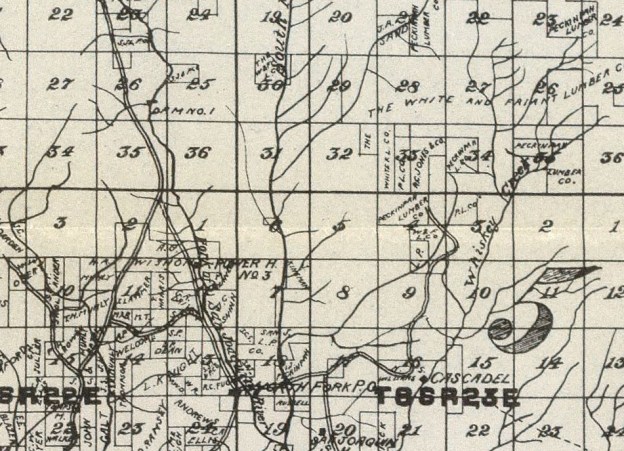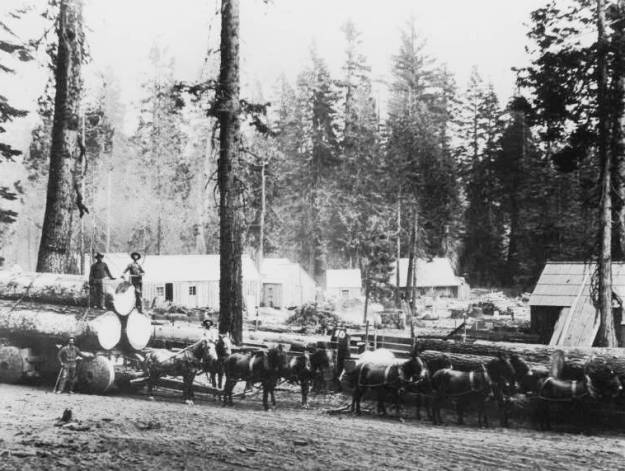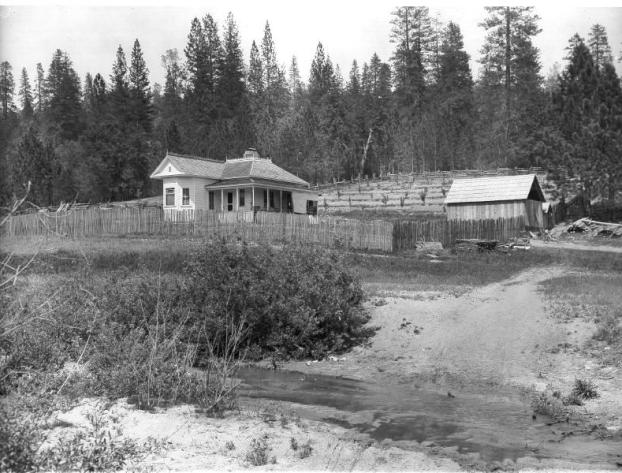After establishing our home on Malum Ridge, looking out onto Peckinpah Mountain, I heard from neighbors about the logging history in our town of North Fork, CA. I became curious about the Peckinpah name and being a bit of a history buff, I decided to dig a bit further. This is what I found.

In Aug 2001, Peckinpah Mountain was scarred and burned in the North Fork Fire, along with our entire property. Luckily only the grass and one tree burned before the fire heated up and climbed the mountain. We built our home here 4 years later.
Peckinpah Mountain rises 6000 feet above Hwy 274 providing south-bound travelers and the people of North Fork grizzled views of Ponderosa, Sugar pines, Oaks and waterfalls. It is also the mountain upon which we look everyday as we walk our dog, Maggie, or work or sit in the garden. High above, is a high country meadow filled with a colorful history. The word Madera or maderas, the name of our county, means wood or ‘lumber’ in Spanish. After the Gold Rush, many folks turned to lumbering on the mountain above our home here in the Sierra Foothills.
The Mill
One lumber mill, set in a meadow bearing his name, was operated by Charles M Peckinpah. He and his brothers started the mill in 1884 and worked it until 1904, the mill giving its name to the old timber trail, now Peckinpah Road. Back then, from North Fork, it would have taken a full day to make the 3000’ foot climb up a steep incline in a wagon pulled by a twelve-mule team.
American author of Westerns and journals of his own experiences in the West, Stewart Edward White, whose cabin was situated two miles from the Peckinpah Mill, wrote of “Uncle Charley” and his family in his 1911 book ‘The Cabin’.
“There is a sawmill two miles distant, over near the bluffs The master sawyer has lived all his life in the mountains — in fact, the meadow bore his name. “Uncle Charley” has a wife and four half-grown boys.
Every once in a while some or all of them take the long ride up the mountain to see us. His home is down the mountain at the Forks. There he often furnishes the music for some of the dances.
This year the mill has sawed its last in the little clearing where it has lived for twenty-five years. It has made a tiny hole in the forest, and has left some ugly debris in its slashings. But even where it cut two years ago, the young trees are springing thick.”
After twenty years of lumbering on Peckinpah Mountain and during a recession, Charles Peckinpah was forced to sell his mill to the Pierce Lumber Company.
The Peckinpahs and the Churches
Denver S. Church, a U.S. Representative from California for three terms, Fresno district attorney, and Superior Court judge, had a long history in the San Joaquin Valley; his father Earle J. Church was a farmer and stock raiser in Fresno and his uncle Moses J. Church worked to bring water to the valley and was considered ‘Father of Fresno Irrigation.’ In 1905 the Churches had purchased the Angel homestead in Crane Valley below Peckinpah Mountain.
In 1915, Charles Peckinpah’s son, David, born on Peckinpah Mountain, met and married Fern Church, daughter of Denver Church. David had gone to North Fork schools before his family moved to Fresno and he studied law, passed the Bar and went into practice at Church, Church and Peckinpah, with his father and brother in law, Denver and Earle J Church.
D Sam
David and Fern Peckinpah had two sons, Denver, called Denny and David Samuel, called D Sam and a daughter, Fern Lea. D Sam went on to become a movie director in Hollywood.
Sam Peckinpah’s second film, ‘Ride the High Country’ included personal references from his own childhood growing up on Denver Church’s ranch, and even named one of the mining towns ‘Coarsegold’, a small town 15 miles away. Some say he based the character of lawman, Steve Judd, on his own father, David, but he says “no, they got too respectable, all judges and lawyers and teetotalers. My grandfather, Charles Peckinpah, started a saw mill up in Madera County outside Fresno, in 1873. There’s a mountain there, the Peckinpah Mountain, where my father was born.”
Peckinpah grew up just at the right time to see the last vestiges of the Old West disappearing. Helping out on his grandfather’s ranch he witnessed the rough life of the cowhand, who worked the ranch, carrying over from the days of gold mining, hunting and trapping. Sam Peckinpah’s father was the real cowboy. He was the foreman of Denver Church’s ranch and drove the stage between North Fork and South Fork.
Although he lived in a middle class home in Fresno, he spent happy days at the ranch on Peckinpah Mountain and at the family’s cabin in Bass Lake riding his horse, Nellie, up around the pines of Crane Valley. He said “It was the finest time of my life. There will never be another time like that again.
“We loved that country, all of us”
In an interview, Sam Peckinpah said, “My earliest memory is being strapped into a saddle when I was two for a ride up into the high country. We were always close to the mountains, always going back to them. When my grandfather was dying, almost his last words were about the mountains. We loved that country, all of us.”

1914 Peckinpah Mountain map. Notice North Fork, Cascadel, at bottom and Peckinpah Lumber Co, just above, perched just above the crest of the mountain. One of the streams shown in sq # 29, middle top, is ‘our’ waterfall.
“My granddad, Denver Church, had a 4,100-acre cattle ranch in the foothills of the Sierras and the whole family, the Peckinpahs and the Churches, had been wandering in that country since moving out from the Midwest in the middle of the twentieth century. We even have a mountain named after us.”
“The people and places in that area! It’s mostly all gone now, chopped up with new roads and resort facilities and overrun with all these (…..) tourists and campers.”
“My brother Denny and I were in on the last of it. A lot of the old-timers dated back to when the place had been the domain of hunters and trappers, Indians, gold miners_ all the drifters and hustlers. All that’s left now are the names to remind you, and what names: towns like Coarsegold and Finegold, Shuteye peak, Dead Man Mountain, Wild Horse Ridge, Slick Rock. Denny and I rode and fished and hunted all over that country. We thought we’d always be part of it.”
To see Peckinpah Mountain and meadow for yourself, drive the Sierra Vista Scenic Byway, Rd 233, starting from North Fork. Peckinpah Road travels from North Fork to Minarets Road through Sierra National Forest, passing Peckinpah Meadow, campsites and hiking trails. Wildflowers are in full bloom late spring and early summer.
Photo credits:
*Logging team from Peckinpah Mill in North Fork, CA, Courtesy NYPL Digital Gallery
**Peckinpah Mill Photo by A W Peters, courtesy Brian Wilhite of White Cloud Photography
***Angell’s Ranch, Crane Valley Gallery of the Open Frontier, University of Nebraska Press
References:
Stewart Edward White THE CABIN
Peckinpah: a portrait in montage by Garner Simmons
Sam Peckinpah: interviews By Kevin J. Hayes
Charlie M Peckinpah photo and info at FindaGrave
History of Fresno and SJ Valley CA PDF Bill and Pat Hayes Family Genealogy
2001 August Fire on Peckinpah Our account of the fire from my diary
Thanks to Alice Williams Kirby for additional background information






11 comments